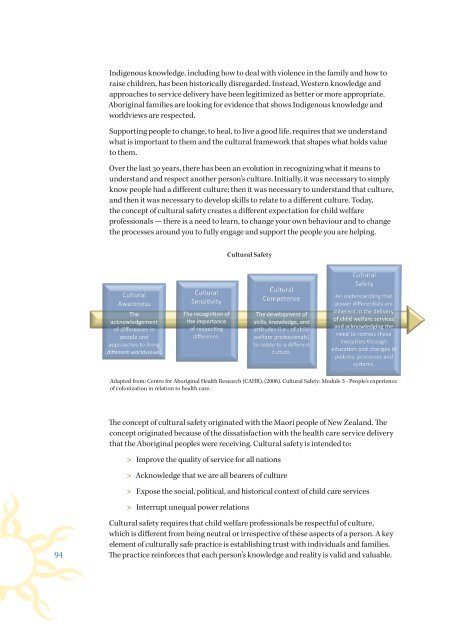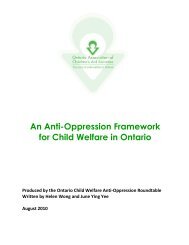English - Ontario Association of Children's Aid Societies
English - Ontario Association of Children's Aid Societies
English - Ontario Association of Children's Aid Societies
Create successful ePaper yourself
Turn your PDF publications into a flip-book with our unique Google optimized e-Paper software.
Indigenous knowledge, including how to deal with violence in the family and how to<br />
raise children, has been historically disregarded. Instead, Western knowledge and<br />
approaches to service delivery have been legitimized as better or more appropriate.<br />
Aboriginal families are looking for evidence that shows Indigenous knowledge and<br />
worldviews are respected.<br />
Supporting people to change, to heal, to live a good life, requires that we understand<br />
what is important to them and the cultural framework that shapes what holds value<br />
to them.<br />
Over the last 30 years, there has been an evolution in recognizing what it means to<br />
understand and respect another person’s culture. Initially, it was necessary to simply<br />
know people had a different culture; then it was necessary to understand that culture,<br />
and then it was necessary to develop skills to relate to a different culture. Today,<br />
the concept <strong>of</strong> cultural safety creates a different expectation for child welfare<br />
pr<strong>of</strong>essionals — there is a need to learn, to change your own behaviour and to change<br />
the processes around you to fully engage and support the people you are helping.<br />
Cultural Safety<br />
Adapted from: Centre for Aboriginal Health Research (CAHR). (2006). Cultural Safety: Module 3 - People’s experience<br />
<strong>of</strong> colonization in relation to health care.<br />
The concept <strong>of</strong> cultural safety originated with the Maori people <strong>of</strong> New Zealand. The<br />
concept originated because <strong>of</strong> the dissatisfaction with the health care service delivery<br />
that the Aboriginal peoples were receiving. Cultural safety is intended to:<br />
> > Improve the quality <strong>of</strong> service for all nations<br />
> > Acknowledge that we are all bearers <strong>of</strong> culture<br />
> > Expose the social, political, and historical context <strong>of</strong> child care services<br />
> > Interrupt unequal power relations<br />
94<br />
Cultural safety requires that child welfare pr<strong>of</strong>essionals be respectful <strong>of</strong> culture,<br />
which is different from being neutral or irrespective <strong>of</strong> these aspects <strong>of</strong> a person. A key<br />
element <strong>of</strong> culturally safe practice is establishing trust with individuals and families.<br />
The practice reinforces that each person’s knowledge and reality is valid and valuable.

















